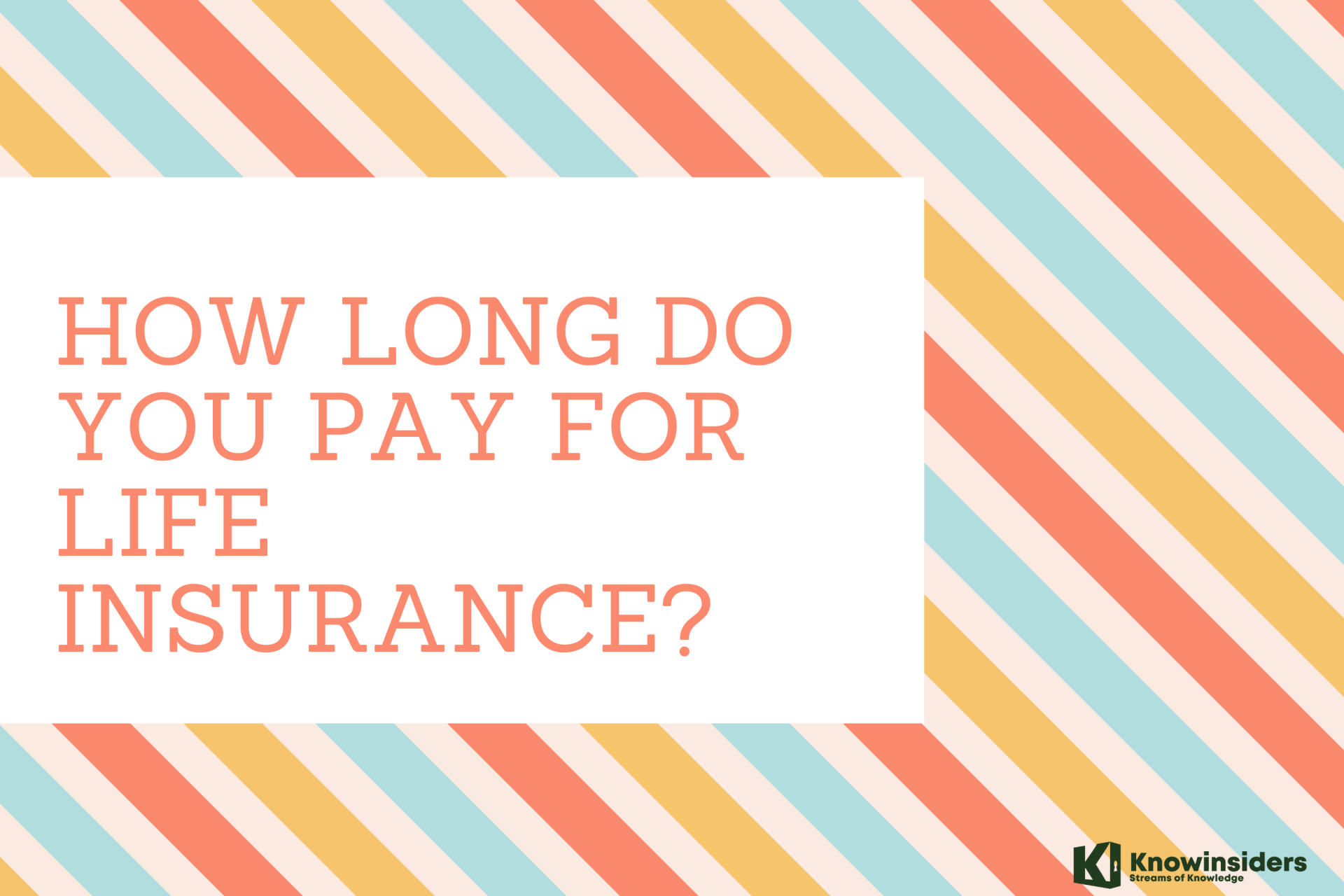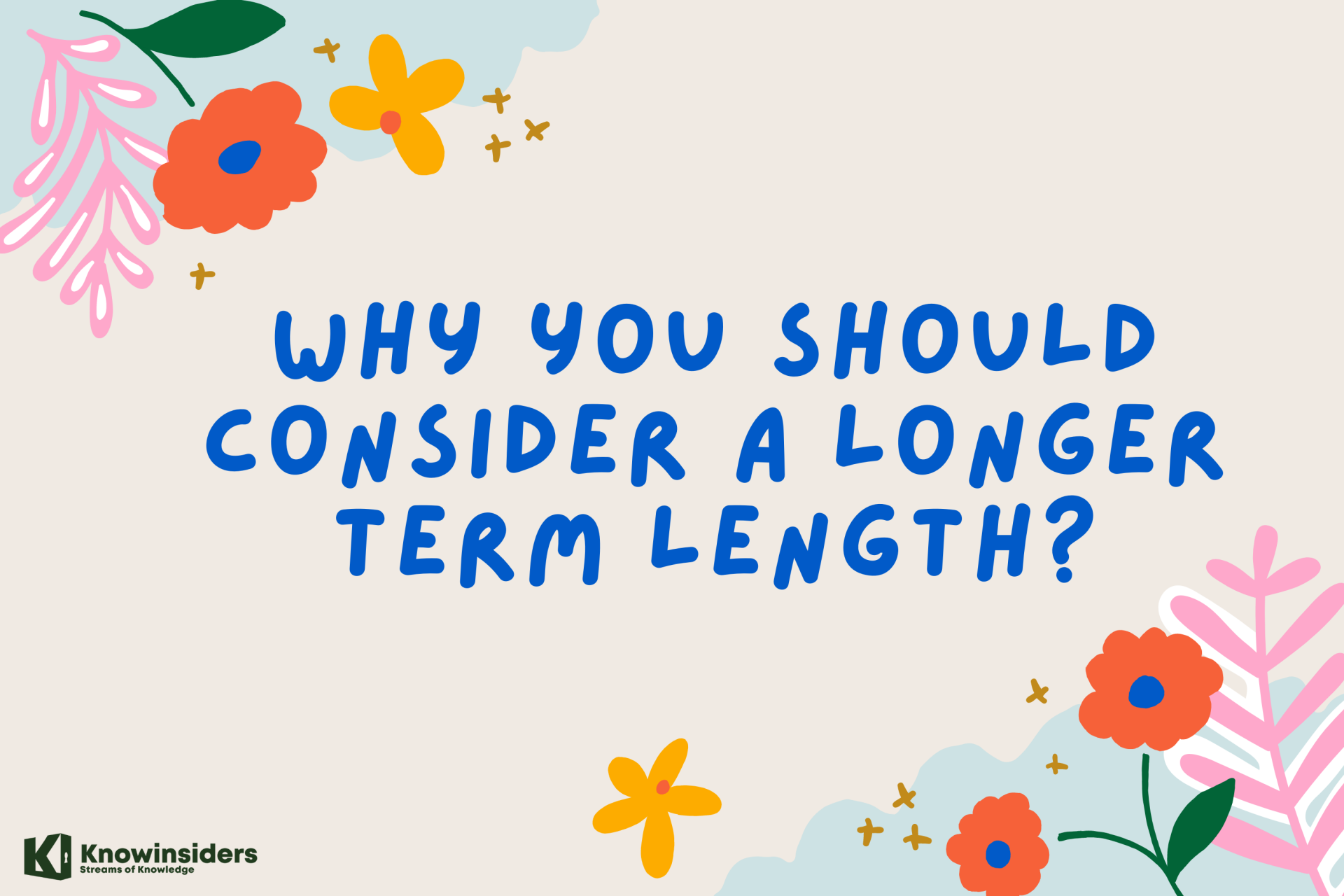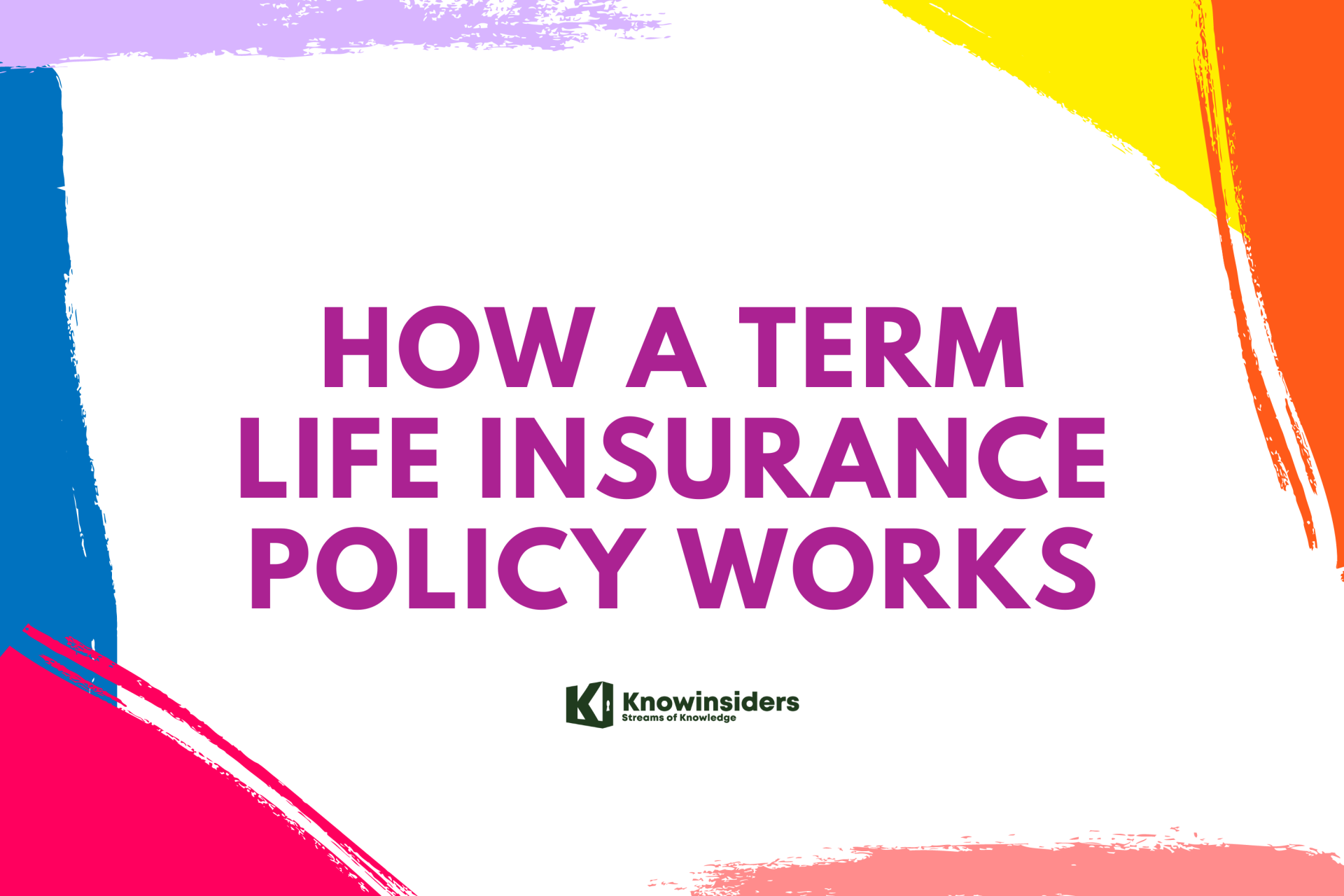Life Insurance: Which Term Length is Right for You
 Life Insurance: Meaning, History, Types and Benefits Life Insurance: Meaning, History, Types and Benefits |
 How to Accelerated Benefits of Life Insurance How to Accelerated Benefits of Life Insurance |
 |
| How Long Do You Pay For Life Insurance? Photo: KnowInsiders.com |
| Contents |
Choosing the amount of coverage and the duration of your term life insurance policy are the two most important choices you will have to make. You want the coverage to last until all of your major debts have been paid off.
Therefore, the length of your debts and mortgage will dictate how long your term life insurance policy should be in effect.
How long is term life insurance?
Typical purchase terms for term life insurance policies are 5, 10, 15, 20, 25, and 30 years. For some people, the best option for term life insurance is a policy that covers them for 40 years. The cost of a life insurance policy increases in direct proportion to the length of time the policy is in effect. Since you're locking in your rate for a longer period of time, and since health issues become more common and mortality rates rise with age, this makes sense.
Coverage under annual renewable term life insurance can be renewed automatically each year for a predetermined number of years without requiring a new application to be submitted. However, premiums typically go up every time a policy is renewed. Therefore, the premiums for a typical level term life insurance policy will decrease over time.
Which term length is right for you?
Take a look at the most typical contract durations and see if any of them work for you.
People with temporary financial commitments or who need a bridge to their next employer's group life insurance policy may benefit from purchasing annual renewable term life.
For those with relatively short-term financial commitments like a student loan or other relatively small expense, a 5-year term life insurance policy could be an excellent choice.
Those who are nearing retirement age and need life insurance to cover the last few years of their career may find 10-year term life insurance to be the most cost-effective option.
The most common term length for life insurance is 20 years, which is sufficient to protect a young couple's income for the first two decades of their family's existence.
Covering major, long-term expenses like a mortgage or student loans is easier with the security of a 30-year term life insurance policy. Young applicants who wish to insure themselves for the majority of their earning years may also find this term length to their liking.
If the longest term of your debt falls between available terms, choose the longer one. As an illustration, if you expect to pay off your mortgage in 17 years, you should choose a term of at least 20 years.
How term length affects cost
Longer contract durations result in higher regular payments. Why? This is due to the increased likelihood that the insurance company will have to pay out the death benefit should the policyholder pass away during the policy's extended term.
Consider the cost of a $500,000 policy over 20 years for a woman aged 35. On the other hand, for the same coverage over 30 years, she would have to pay $37.35.
If you think you might need more coverage in the future, buying a policy with a longer term can help you lock in cheaper premiums. However, you shouldn't spend more than you have to on insurance, so it's important to shop around for a reasonable term length. You should have enough money and assets to self-insure, especially for last-minute medical expenses, after your policy expires.
The success of your family's financial plan depends on your ability to choose the optimal term length for your insurance policy. Free assistance from a policygenius agent is available to ensure you have adequate protection.
Why you should consider a longer term length
 |
| Photo: KnowInsiders.com |
Once you evaluate your financial obligations you can determine exactly how long your term life policy should last. In certain situations, it may be worthwhile to have a policy that lasts longer than necessary.
You've never had cheaper life insurance rates than you do right now.
In general, life insurance costs between 4.5 and 9% more for each year you live, but this can rise even higher based on your health status. In the future, when applying for a new policy, your rates may increase if you or your close relatives are diagnosed with a serious illness. The premiums will skyrocket if you buy a 20-year policy now but need to extend it later.
You also can't anticipate what rates will be like 20 years from now due to factors like inflation and industry shifts. Currently, a 50-year-old may find the rates to be prohibitive, but in 20 years, they may be completely out of reach.
Life is unpredictable
It may make sense to have a shorter term length right now, but there are a lot of unknowns that could cause that to change in the future. Perhaps you'll have another child, decide to stay at home with your parents, or stop working. With each major life change comes a reevaluation of your life insurance needs.
In addition, it is important to plan for the costs associated with the end of life. According to Genworth's 2020 Cost of Care survey, a private nursing home room costs an average of $8,821 per month. Meanwhile, the average funeral can set your loved ones back between $8,000 and $10,000. Your loved ones may have to take on debt to pay for your funeral and burial expenses, even if they no longer rely on you financially.
Having a safety net for your family that goes beyond their basic requirements is important even if they are not financially dependent on you.
There's always the option of reducing your coverage if costs become too high (and how much you pay)
Twenty years into a 30-year policy, you may find that you no longer require life insurance coverage; in this case, you are free to cancel your policy. You can reduce the amount of coverage on your policy without having to go through underwriting again, saving you money. Otherwise, you can terminate your policy. This is much more cost-effective than applying for a new life insurance policy at much higher rates in the future.
How to determine the amount you need – and where to get it
It will take a lot of money and time to raise a family from the time the children are born until they are financially independent adults. Life insurance can help cover your loved ones' living expenses if you are no longer able to do so, but only if the death benefit is sufficient. Some guidelines for estimating requirements are provided below.
Get 10x your salary: This is one of the simplest rules to follow, and it can provide a useful cushion for your family – but it doesn’t take all your actual expenses and needs into account.
Get 10x your salary, plus college expenses: If you add $100,000 - $150,000 for each child, that can help ensure they can achieve more of the opportunities you want for them.
Use the DIME formula: DIME stands for Debt, Income, Mortgage, and Education. Total your debts, mortgage and college expenses, plus your salary for the number of years your family needs protection (e.g., until the children are out of the house), and that’s your coverage need.
There are financial advisors who use a concept called "Human Life Value," which takes into account both your current and future earning potential, to determine how much money you'll need. The basic tenet of this philosophy is to increase your income by some factor that takes into account things like your age, occupation, expected number of working years, existing benefits, and so on. Many factors determine how much insurance you should buy, but if you're between the ages of 18 and 40, a good starting point is to multiply your annual salary by 30. There is an age-specific adjustment in the formula, so please consult the appropriate table below.
| Age | Maximum Life Insurance |
| 18-40 | 30 times income |
| 41-50 | 20 times income |
| 51-60 | 15 times income |
| 61-65 | 10 times income |
| 66-70 | 1 times net worth |
| 71-75 | 1/2 times net worth |
How a term life insurance policy works
 |
| Photo: KnowInsiders.com |
This is an official legal document. When it comes down to its barest essentials, a term life insurance policy is an agreement between the policy's owner (the owner) and the insurance company: An insurance policy is a contract between an insurance provider and its buyer, who, in exchange for regular premium payments over a set period of time (typically 10–30 years), guarantees the buyer a predetermined amount of money (the death benefit) upon the buyer's death (the insured). That perk is generally exempt from taxes (unless the premiums are paid with pre-tax dollars).
You have to fill out an application first. There are advertisements that state, "A male non-smoker in his thirties can get a 20-year $500,000 term policy for under $30 a month." That much protection can be had by some for less than $30 per month, but it is not guaranteed to anyone. The insurer will determine your level of risk before issuing you a policy. The term "underwriting" refers to this phase. In order to assess your health, they'll likely request a physical and ask you questions about your background and habits. The cost of insurance might go up if you engage in a potentially dangerous hobby like scuba diving. Your premiums may also go up if you work in a hazardous environment, such as an oil rig.
Pick a time frame for your commitment. How long will I need coverage for is a crucial question to ask. As a general rule, parents should select a term that will last until their youngest child has graduated from college. In general, the higher the coverage amount, the higher the monthly premium. Although it is impossible to predict the future, it is easier to obtain insurance when you are younger and in good health, so it is usually best to err on the side of getting a longer-term policy rather than a shorter one.
You can customize the death benefit to your needs and wishes. In section 3, we'll go over some of the methods you can use to calculate how much insurance coverage will be adequate to meet your family's needs in the event of your untimely demise. Whatever level of protection you seek, you can expect to pay less than you initially anticipated. Recent research has found that nearly half of today's young adults (44%, to be exact) incorrectly estimate the true cost of life insurance to be at least five times higher. 1
Identify who will receive your assets. When you pass away, who gets the money? No single recipient is required. You could, for instance, leave half to your partner and the other half to your grown children. Beneficiaries are typically members of the same family, but this is not always the case. You have the option of leaving all or a portion of your benefits to a trust, a charity, or a loved one.
READ MORE: What is Business Insurance: Definition, Types and Cost
The different types of term policies you can buy
There are many different types of term insurance policies, and you may hear about them as you begin your search and begin talking to various providers and agents. They all offer the same service for the same length of time, but their extra features and prices can vary widely.
To simplify things, the most typical type of insurance policy has a premium that remains constant throughout the policy's duration (sometimes referred to as a "level premium" or "level term").
An annual renewable term is another name for a term that can be renewed every year. This policy provides annual coverage at a gradually increasing premium, and you can renew it year after year without undergoing a medical exam. In the beginning, your premiums will be lower than they would be with a level term policy, but by the end of the 10, 20, or 30-year term, you will have paid more.
If you outlive the policy's term, you'll receive a refund of all or a portion of your premiums. Exactly what is the catch, if any? Your rates may be two to four times what they would be under a level term plan. If your financial situation changes and you let your policy lapse, you may not get any of your premiums back at all.
There is no medical exam required for these policies, and only a few basic health questions are asked. Because of the additional risk you pose to the insurance provider, your premiums could be significantly higher than they would be otherwise. Another possible drawback is that the death benefit is reduced in the first few years of the policy. Traditional underwritten term life insurance is a good option if you have health problems but are able to manage them (i.e., requires a medical exam).
How Long Do I Pay for Term Life Insurance?Variables such as age, health, and income can all affect how long you have to pay for your life insurance. Term life insurance requires a premium payment for a predetermined time frame, typically 10, 15, 20, or 30 years. You get to decide how long the policy will be in effect for when you buy it, and if you die during that time, only your beneficiaries will receive the death benefit. Depending on the terms of your policy, you may be able to renew your term life insurance after the initial term expires. However, the premium cost of your new policy will likely be much higher when extending coverage past the initial term because your rate was only guaranteed for the original term of your policy. |
 Best Tips To Purchase Health Insurance Best Tips To Purchase Health Insurance Buying insurance is a significant investment, and you’ll want to invest wisely. Check out this article to know 10 tips to consider before buying health ... |
 What Is Mortgage Insurance and How Does It Work? What Is Mortgage Insurance and How Does It Work? What is mortgage insurance, how it works, and what are its benefits? Scroll down to understand more details about the advantages of mortgage insurance. |
 What is Business Insurance: Definition, Types and Cost What is Business Insurance: Definition, Types and Cost Business Insurance is one of the most important parts if you want to start a business, which will help protect your businesses against losses. |



























